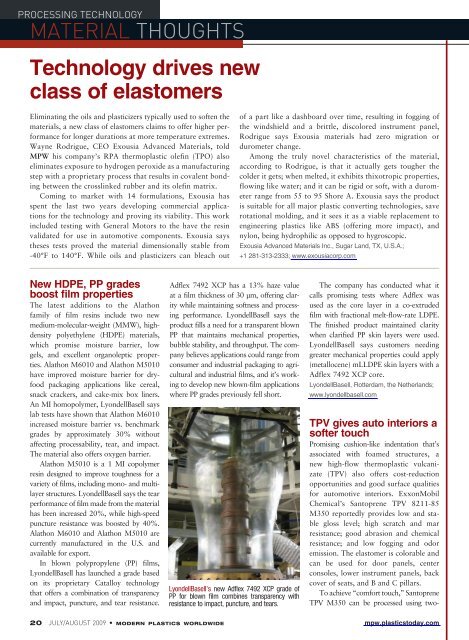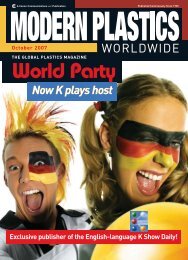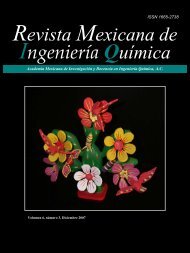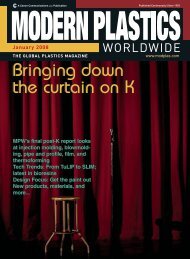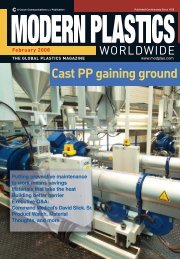Modern Plastics Worldwide - July/August 2009 - dae uptlax
Modern Plastics Worldwide - July/August 2009 - dae uptlax
Modern Plastics Worldwide - July/August 2009 - dae uptlax
Create successful ePaper yourself
Turn your PDF publications into a flip-book with our unique Google optimized e-Paper software.
PROCESSING TECHNOLOGY<br />
MATERIAL THOUGHTS<br />
Technology drives new<br />
class of elastomers<br />
Eliminating the oils and plasticizers typically used to soften the<br />
materials, a new class of elastomers claims to offer higher performance<br />
for longer durations at more temperature extremes.<br />
Wayne Rodrigue, CEO Exousia Advanced Materials, told<br />
MPW his company’s RPA thermoplastic olefin (TPO) also<br />
eliminates exposure to hydrogen peroxide as a manufacturing<br />
step with a proprietary process that results in covalent bonding<br />
between the crosslinked rubber and its olefin matrix.<br />
Coming to market with 14 formulations, Exousia has<br />
spent the last two years developing commercial applications<br />
for the technology and proving its viability. This work<br />
included testing with General Motors to the have the resin<br />
validated for use in automotive components. Exousia says<br />
theses tests proved the material dimensionally stable from<br />
-40°F to 140°F. While oils and plasticizers can bleach out<br />
New HDPE, PP grades<br />
boost fi lm properties<br />
The latest additions to the Alathon<br />
family of film resins include two new<br />
medium-molecular-weight (MMW), highdensity<br />
polyethylene (HDPE) materials,<br />
which promise moisture barrier, low<br />
gels, and excellent organoleptic properties.<br />
Alathon M6010 and Alathon M5010<br />
have improved moisture barrier for dryfood<br />
packaging applications like cereal,<br />
snack crackers, and cake-mix box liners.<br />
An MI homopolymer, LyondellBasell says<br />
lab tests have shown that Alathon M6010<br />
increased moisture barrier vs. benchmark<br />
grades by approximately 30% without<br />
affecting processability, tear, and impact.<br />
The material also offers oxygen barrier.<br />
Alathon M5010 is a 1 MI copolymer<br />
resin designed to improve toughness for a<br />
variety of films, including mono- and multilayer<br />
structures. LyondellBasell says the tear<br />
performance of film made from the material<br />
has been increased 20%, while high-speed<br />
puncture resistance was boosted by 40%.<br />
Alathon M6010 and Alathon M5010 are<br />
currently manufactured in the U.S. and<br />
available for export.<br />
In blown polypropylene (PP) films,<br />
LyondellBasell has launched a grade based<br />
on its proprietary Catalloy technology<br />
that offers a combination of transparency<br />
and impact, puncture, and tear resistance.<br />
Adflex 7492 XCP has a 13% haze value<br />
at a film thickness of 30 μm, offering clarity<br />
while maintaining softness and processing<br />
performance. LyondellBasell says the<br />
product fills a need for a transparent blown<br />
PP that maintains mechanical properties,<br />
bubble stability, and throughput. The company<br />
believes applications could range from<br />
consumer and industrial packaging to agricultural<br />
and industrial films, and it’s working<br />
to develop new blown-film applications<br />
where PP grades previously fell short.<br />
LyondellBasell’s new Adflex 7492 XCP grade of<br />
PP for blown film combines transparency with<br />
resistance to impact, puncture, and tears.<br />
of a part like a dashboard over time, resulting in fogging of<br />
the windshield and a brittle, discolored instrument panel,<br />
Rodrigue says Exousia materials had zero migration or<br />
durometer change.<br />
Among the truly novel characteristics of the material,<br />
according to Rodrigue, is that it actually gets tougher the<br />
colder it gets; when melted, it exhibits thixotropic properties,<br />
flowing like water; and it can be rigid or soft, with a durometer<br />
range from 55 to 95 Shore A. Exousia says the product<br />
is suitable for all major plastic converting technologies, save<br />
rotational molding, and it sees it as a viable replacement to<br />
engineering plastics like ABS (offering more impact), and<br />
nylon, being hydrophilic as opposed to hygroscopic.<br />
Exousia Advanced Materials Inc., Sugar Land, TX, U.S.A.;<br />
+1 281-313-2333; www.exousiacorp.com<br />
The company has conducted what it<br />
calls promising tests where Adflex was<br />
used as the core layer in a co-extruded<br />
film with fractional melt-flow-rate LDPE.<br />
The finished product maintained clarity<br />
when clarified PP skin layers were used.<br />
LyondellBasell says customers needing<br />
greater mechanical properties could apply<br />
(metallocene) mLLDPE skin layers with a<br />
Adflex 7492 XCP core.<br />
LyondellBasell, Rotterdam, the Netherlands;<br />
www.lyondellbasell.com<br />
TPV gives auto interiors a<br />
softer touch<br />
Promising cushion-like indentation that’s<br />
associated with foamed structures, a<br />
new high-flow thermoplastic vulcanizate<br />
(TPV) also offers cost-reduction<br />
opportunities and good surface qualities<br />
for automotive interiors. ExxonMobil<br />
Chemical’s Santoprene TPV 8211-85<br />
M350 reportedly provides low and stable<br />
gloss level; high scratch and mar<br />
resistance; good abrasion and chemical<br />
resistance; and low fogging and odor<br />
emission. The elastomer is colorable and<br />
can be used for door panels, center<br />
consoles, lower instrument panels, back<br />
cover of seats, and B and C pillars.<br />
To achieve “comfort touch,” Santoprene<br />
TPV M350 can be processed using two-<br />
20 JULY/AUGUST <strong>2009</strong> • MODERN PLASTICS WORLDWIDE mpw.plasticstoday.com


